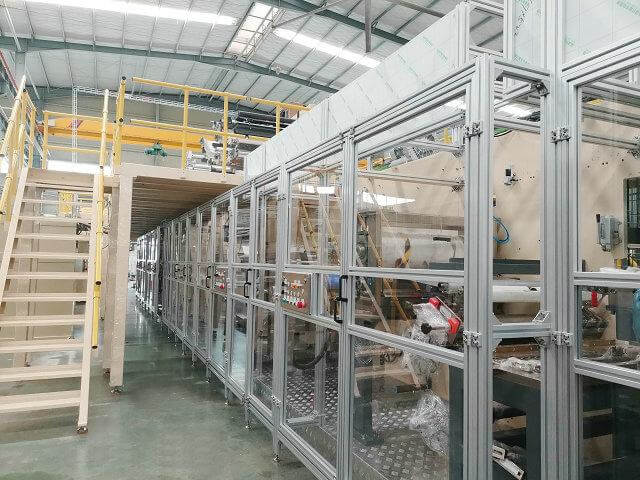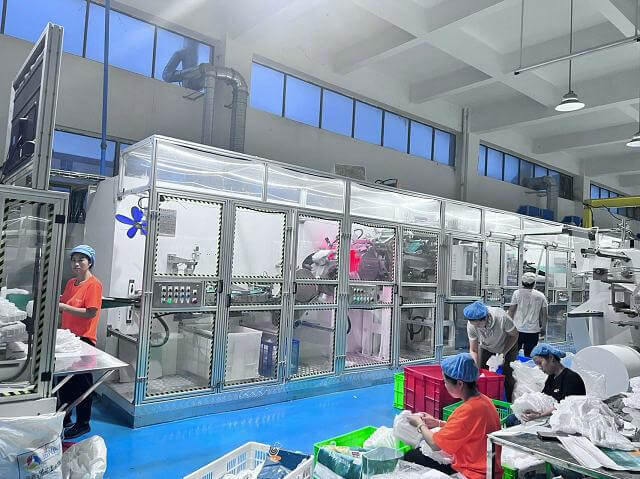Author:Haina Machinery Factory FROM:Diaper Machinery Manufacturer TIME:2023-11-20
Exploring the Versatility of Diaper Production Lines

Diapers have become an essential product for parents worldwide, providing comfort and convenience for their babies. The production of diapers involves intricate processes that ensure the highest quality and efficiency. In recent years, various advancements in technology and innovation have made diaper production lines highly versatile, allowing manufacturers to cater to different market demands and produce a wide range of diaper types. This article aims to explore the versatility of diaper production lines and how it enables manufacturers to meet the evolving needs of consumers.

One of the key factors in the versatility of diaper production lines is the implementation of automated material handling systems. These systems can handle different sizes and types of materials used in diaper manufacturing, such as absorbent cores, topsheets, and back sheets. By utilizing robotic arms and conveyors, manufacturers can easily switch between different materials and customize the production process according to specific requirements. This flexibility allows for the production of various diaper sizes and designs without compromising efficiency.

The modular machine configurations in modern diaper production lines contribute significantly to their versatility. Manufacturers can easily add or remove modules to adapt to changing production demands. For example, if there is a surge in demand for a specific diaper type, manufacturers can quickly add an additional module to increase production capacity. Similarly, if there is a need to introduce new features or improve existing ones, modules can be replaced or modified accordingly. This modular approach enhances the efficiency and flexibility of diaper production lines.
Flexographic printing technology has revolutionized the design possibilities in diaper production. Manufacturers can now produce diapers with intricate and vibrant prints, giving them a competitive edge in the market. This technology allows for quick color changes and precise printing, enabling manufacturers to offer customizable designs and patterns. With flexographic printing, diaper production lines can easily adapt to seasonal trends, special promotions, or personalized requests from consumers, expanding their versatility in meeting diverse customer preferences.
Gone are the days when diaper production lines were restricted to producing a single size of diapers. Thanks to advancements in technology, modern production lines can effortlessly switch between different diaper sizes. This flexibility is achieved through automated size changeovers, where the machines adjust settings and dimensions according to the desired diaper size. Manufacturers can cater to the needs of infants, toddlers, and even adults, expanding their market reach and maximizing production efficiency.
The demand for eco-friendly products has significantly influenced the diaper manufacturing industry. Today, diaper production lines are designed to produce environmentally friendly diapers with minimal carbon footprint. Manufacturers have incorporated sustainable materials, such as biodegradable absorbent cores and plant-based topsheets, into their production processes. This shift towards eco-friendly manufacturing demonstrates the versatility of diaper production lines in adapting to changing consumer preferences and addressing environmental concerns.
The integration of smart technologies, such as artificial intelligence and machine learning, has further enhanced the versatility of diaper production lines. These technologies enable real-time monitoring and analysis of production data, optimizing machine performance, and reducing downtime. By predicting potential machine failures or quality issues, manufacturers can take proactive measures to ensure uninterrupted production and maintain product quality. The adoption of smart technologies in diaper production lines allows for greater adaptability and efficiency.
Diaper production lines' versatility extends beyond manufacturing branded products. Many manufacturers offer private label production services, allowing retailers or entrepreneurs to have their own diaper brands. These production lines can easily switch between different specifications, designs, and packaging options based on the private label requirements. This versatility opens up opportunities for small businesses to enter the diaper market and cater to niche customer segments, further fueling industry growth.
The versatility of diaper production lines relies on continuous innovation and customization. Manufacturers constantly invest in research and development to introduce new features, improve product performance, and enhance user experience. From moisture indicators to stretchable waistbands, diaper production lines are equipped to accommodate these innovations seamlessly. By staying at the forefront of technology and consumer trends, manufacturers can meet evolving customer needs and drive the growth of the diaper industry.
The versatility of modern diaper production lines is a testament to the industry's commitment to meeting diverse customer demands. Through automated material handling systems, modular machine configurations, advanced printing technology, multi-size production capabilities, eco-friendly practices, smart technologies, private label production, and continuous innovation, manufacturers can produce diapers for various age groups, preferences, and environmental concerns. As the diaper industry continues to evolve, the versatility of production lines will play a vital role in ensuring high-quality and customizable products for babies worldwide.
